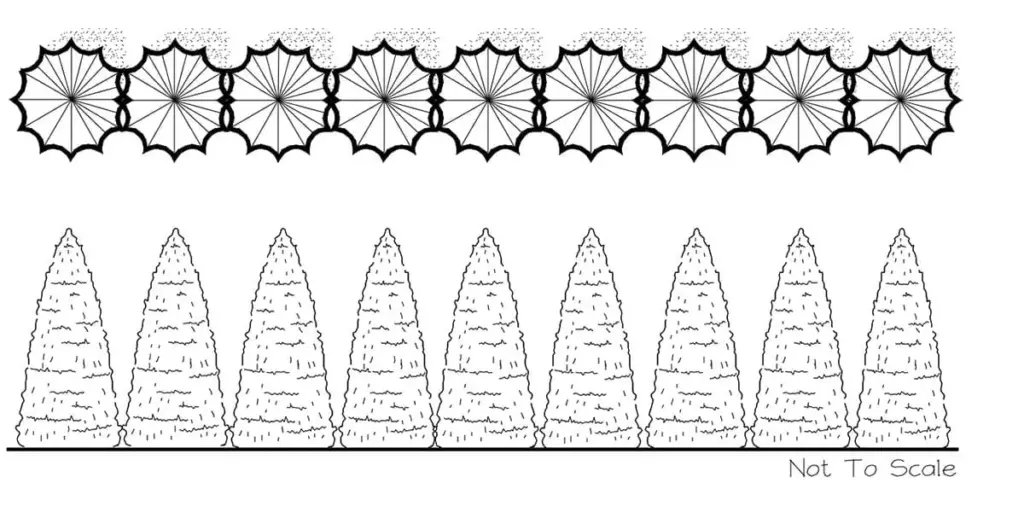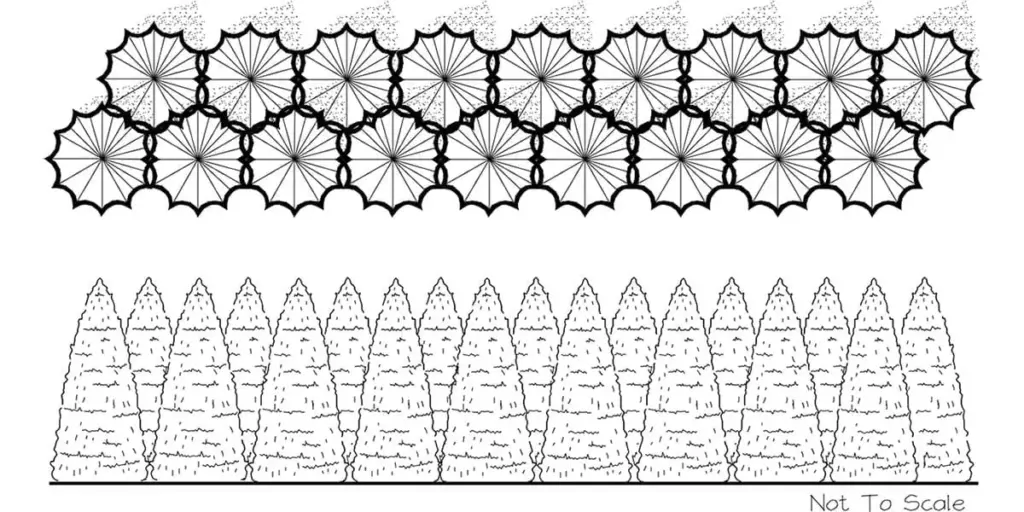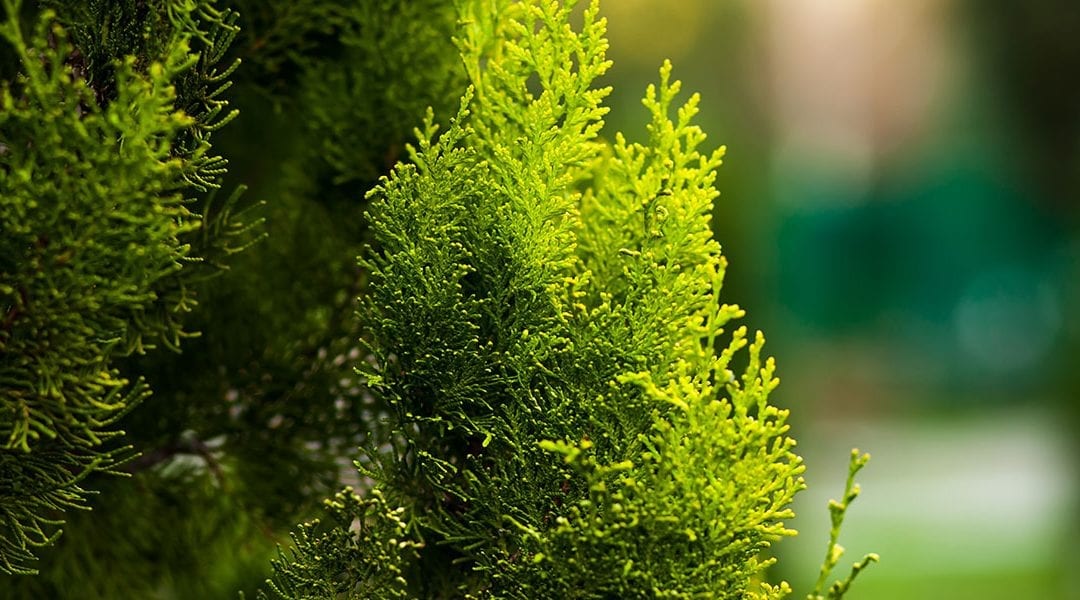¿Dónde puedo plantar arborvitae? Arborvitae, or ‘arbs’ for short, prefer to be planted in full sun areas that receive 6+ hours of sun per day. However, several varieties can thrive in partial shade areas that get 4-6 hours of sun per day. Most arborvitae varieties do not like shady conditions; the more sun they get, the happier they will be. Lastly, be sure the area where they are planted does not have standing water during the season; arbs do not like having wet feet.
¿Cuántas arborvitas 'Emerald Green' necesito? Many customers install arbs in long rows along their property lines to block neighbors, reduce noise pollution and hide unsightly views like roads and sheds. Regardless of size, Platt Hill Nursery recommends a spacing of 3′ from center-of-pot to center-of-pot. When using 3′ spacing, take the distance that needs coverage, say 30 feet, and divide that distance by 3 to get an idea of how many arbs are needed. So, 30 ÷ 3 = 10 arbs. Keep in mind, there will be small gaps in between each plant after installation, but the gaps will fill in after a few years.
If coverage is needed immediately, most arborvitae can be installed needle-to-needle or at whatever spacing is desired; they are meant to growth together to provide privacy coverage. Ultimately, the quantity needed depends on this question: are you willing to wait for the gaps to fill in or do you need coverage now?
Tip: When installing smaller quantities of plants, use ‘The Rule of Odds’ and plant in odd numbers like 1, 3, 5, 7, 9, & 11 for a more pleasing and natural look in the landscape.
¿Cómo debo espaciar las arborvitas? A continuación se presentan dos métodos comunes para espaciar las arborvitas: en una sola fila y de forma escalonada. Las plantaciones en una sola fila requerirán un lecho de plantación más pequeño, pero pueden tardar más tiempo en dar una cobertura completa debido a los espacios entre las plantas. Por otro lado, las hileras escalonadas le proporcionarán una cobertura más inmediata, pero requerirán un lecho de plantación más profundo y pueden dar lugar a huecos entre las plantas cuando no se ven de frente.
Fila simple

Filas escalonadas

¿Cómo debo plantar el arborvitae? Consulte nuestra hoja de detalles de plantación disponible en los registros y en nuestro sitio web.
Consejo: Si planta en una zona baja que a veces tiene agua estancada, instale los arbustos un poco más altos de lo normal. Excave entre ½ y ¾ del cepellón en el suelo y, a continuación, haga un montículo con una mezcla de tierra vegetal y compost en la parte superior del cepellón e incline gradualmente la tierra. Al elevar el cepellón fuera del agua estancada, las plantas tendrán más posibilidades de sobrevivir.
Should I add anything to the soil when I install ‘Emerald Green’ Arborvitae? Yes, Chicagoland soil typically has lots of clay and even gravel in some areas with a thin layer of top soil. Because of this, amending the soil is extremely important when installing ANY plant material – not just arborvitae trees. A mixture of top soil and One Step soil conditioner are vital to give plants a good start. Applying a 2-3″ layer of hardwood mulch on top will regulate soil temps, improve moisture retention and helps to keep weeds from growing. It also looks better than exposed soil.
¿Con qué frecuencia debo regarlas? Please refer to our ‘To Water or Not to Water?’ sheet available at the registers or follow the link.
Tras la plantación, siga comprobando las necesidades de agua de la arborvita hasta bien entrado el invierno. Esto podría significar regar en diciembre e incluso en enero si tenemos un invierno suave con muy pocas nevadas y días intempestivamente cálidos. Muchos clientes dejan de regar sus arbustos en otoño cuando llegan las temperaturas más frías y, como resultado, las plantas se secan en invierno por falta de humedad. Los arbustos no pueden utilizar el agua congelada del suelo durante el invierno, así que asegúrese de aplicar abundante agua a las plantas nuevas antes de que bajen las temperaturas.
Consejo: Las plantas perennes reaccionan con lentitud y, por lo general, no muestran signos de estrés hídrico hasta mucho después de que se haya producido. Por eso es importante comprobar regularmente las necesidades de humedad del suelo.
¿A qué velocidad crece la Arborvitae 'Emerald Green'? The answer to this question depends on multiple factors in your landscape. Water, sunlight, soil type, fertilizing schedule and weather conditions all play a part in the growth rate of arbs. Generally, categorized as having a medium growth rate; 6-12″ per year. Here in the Midwest, their growth cycle tends to be: fatten out, then grow up, fatten out, then grow up, and so on.
Consejo: Después de la instalación, la mayoría de los árboles de hoja perenne tardan unos 2 años en desarrollar un sistema de raíces adecuado. El tercer año es cuando se suele notar un crecimiento superior significativo.
¿Cómo y cuándo debo podar mi arborvitae? La poda de la arborvita 'Emerald Green' rara vez es necesaria debido a su ritmo de crecimiento y su forma. Sin embargo, si es necesario podar, la parte superior de la arborvita se puede podar hasta un punto y los lados se pueden recortar con un cortasetos o podadoras para controlar la anchura. El Vivero Platt Hill recomienda podar las arborvitas a finales del invierno, antes de que surja el nuevo crecimiento, o después de que éste se haya desarrollado a finales de la primavera. NO PODE EN OTOÑO. Las ramas muertas o rotas pueden eliminarse durante todo el año, incluso en otoño.
El interior de mi arborvitae se vuelve marrón en otoño. ¿Qué ocurre? Don’t be alarmed. This seasonal needle drop is normal for most evergreen trees. They drop needles that are 2-4 years old every fall as part of their natural growth process. If needle tips are browning, give us a call.
Información importante para el éxito ‘Emerald Green’ Arborvitae are very winter hardy Zone 4 plants. Once established, they provide years of reliable green beauty and screening. Often times, when planting arbs in large numbers, there is a tendency to cut corners in order to finish the job quickly. For maximum success, install each plant correctly by digging a proper sized hole, using the right soil amendments and watering regularly. Ultimately, installing arborvitae correctly and providing adequate water gives your plants the best chance of success.
Platt Hill Nursery es el principal centro de jardinería y vivero de Chicago. Learn more about arborvitae varieties. Versión descargable para imprimir Why is my evergreen turning brown? 

